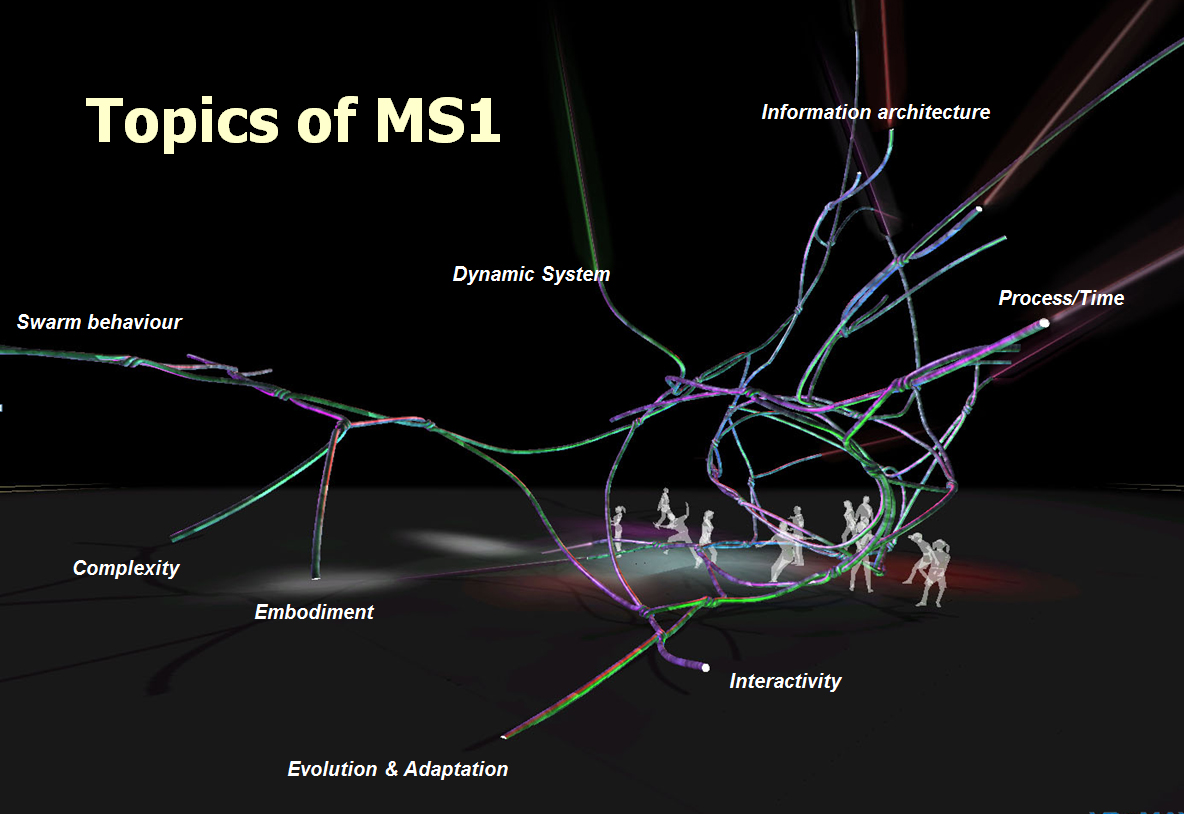Media studies brief
File:Media Studeis course brief.pdf
Media Studeis – Fall 2011 Course Brief
MS1 Media Studeis Theory background on the influence of digital technology on society, culture & architecture
Course Code: AR1Aue070
Course Title: Media Studies
Course Coordinator: Xin Xia
Course Tutors: Kas Oosterhuis, Walter Aprile, Tineke Reijnders, Michela Turin, Gijs Joosen, Berndard Sommer, Christian Derix, Manuel Kretzer
Credit points: 3
This course is designed as an inquiry into the field of the development of non-standard and interactive Architecture.
Related topics are:
Evolution & Adaptation
Evolution and adaptation, behavior and self-organization are part of an architectural network inspired by biology. This network is provided by “agents” or “cyber-entities” that implement behaviors obtaining and exchanging energy in order to survive in their network environment. This is analogous to real biological entities that acquire and consume energy (or food) for their survival. Also, they may interact with their network environment and other cyber-entities through environmental sensing and communication.
Complexity
The field of complex systems, with its investigations into how relationships between simple parts give rise to complex collective behaviours of a system and how these systems interact and form relationships with their environment serves as a perfect correlation for developing interactive architectural systems. A systemic approach taken up by Hyperbody, which filters through the understanding of complex systems has resulted in generating performative aspects of networked architectural bodies owing to bi-directional relations among its constituting components, these components with the environment and with users.
Swarm behaviour
The swarm is a generic mission architecture consisting of miniaturized, autonomous, self-similar, reconfigurable, addressable components forming structures. The components/structures have wide spatial distribution and multi-level organization. This ‘swarm’ behavior is inspired by the success of social insect colonies where within their specialties, individuals outperform generalists and with sufficiently efficient social interaction and coordination, groups of specialists outperform groups of generalists.
Interactivity
Interactive architecture is a newly emerging branch of architectural design, made possible due to developments in information technology and availability of new materials that allow extending buildings with information processing, sensing and actuating properties. In opposition to traditional architecture the design essence of interactive architectural objects lies not only in their physicality, but also in their behaviour, both densely interwoven with each other. In order to create successful architectural objects of this kind, their spatial and behavioural expression has to be designed in a way that fully opens up the possibilities of interaction with their environment.
Information architecture
The ability of digital media to frame questions and interrogate issues pertaining to conceptualization, representation and simulation of architectural design challenges the role of traditional media in architecture: computer programs, for instance, influence design, while their use in different phases of the design process establishes a modus operandi new to architecture. Architects generate digital information that can be used in fabrication and construction to directly drive computer-controlled machines and produce building components, challenging the still persistent traditional modes of production.
Process/Time
Solids reset the concept of time but on the opposite time is the most important element for liquid architecture. Real time computing implies applications and systems, which operate to an input-output latency of seconds, enabling response to stimuli within milli or microseconds. Hyperbody research dwells into exploring Real Time Behaviour via computational concepts based on motion kinematics and dynamics. The combination of the knowledge filtered from Kinematics, a field which studies motion without consideration of mass or external forces, and Dynamics, a field which takes into consideration physical properties such as mass, elasticity and physical forces such as gravity, inertia are researched upon for developing real-time interactive spatial environments.
Such environments owing to their real-time data communication and processing abilities prove to rather efficient in enhancing the performance of space by means of generating possibilities for spatial re-organization and re-configuration. The resultant spatial environment can rightly be termed as ‘Hyperarchitecture’.
Tasks for students:
1. Read the readers on topics related to the lectures in advance;
2. Students are expected to actively attend the lectures and discussions;
3. Students will have to submit their findings/ understandings/ researches on the joint part of any two topics, in the form of:
Essay / film / animation / poster / booklet / installation / interview / story / map of interaction …
Important dates:
15 Oct. Send written proposal on one page of A4 (topics, form)
23 Oct. Get feedback
23 Dec. Submit the assignment
